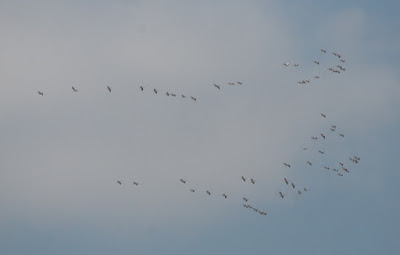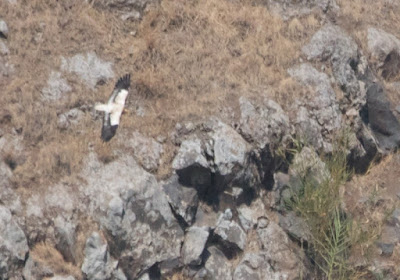Our route took us north and east from Tel Aviv, past dry fields and scattered olive groves.
Israel is part of a major migration route around the eastern end of the Mediterranean, and we were there at a peak time to catch the southward passage. At a stop en route I saw flocks of Great White Pelicans (Pelecanus onocrotalus) flying high overhead...
... and a number of Short-toed Eagles (Circaetus gallicus), one of the most striking of European raptors, on their way southward to Africa.
Our route took us to the town of Tiberias and around the southern end of the Sea of Galilee. Like the Dead Sea, this is not a sea but a lake, also known as Lake Tiberias. It has the distinction of being the lowest freshwater lake in the world, second only in that regard to the Dead Sea (which is, famously, salty).
Our first major stop was the Gamla Nature Reserve, a highland area to the north and east of the Sea of Galilee. Gamla (which means camel) is a popular tourist attraction as well as being of both archaeological and biological interest.
It was also not a bad bird spot, though I’m sure we would have seen more if we were not already in the middle of the day. My highlight was a Woodchat Shrike (Lanius senator), one of the most colourful members of the shrike family and a new species for me. It is a common summer breeder in the Golan Heights, where it is the most abundant of Israel’s four shrike species, so I was certainly in the right place to find one.
From the reserve entrance we followed the trail to the reserve’s main archaeological site, the ancient settlement of Gamla.
On the way I dawdled behind the others to take pictures of trailside plants. As readers of this blog will know, I am no botanist, and was unable to identify even the few plants that were still in flower (though the upper photograph certainly shows some sort of composite).
In the dry autumn season, though, most of the plants were reduced to dried stalks and often-picturesque seed heads, making identification even more of a challenge. This, for example, looks like some sort of sunflower relative, but I have no idea of what it actually is.
As far as I can tell, this spindly cluster of flowers belongs to Fennel (Foeniculum vulgare), a common garden vegetable elsewhere and a native here.
This rather weird object is the seed head of a globe thistle (Echinops sp., presumably E. adenocaulis), a plant that is a lot more colourful in June and July, when it flowers.
These are the dried remains of distaff thistles, members of the genus Carthamus. Based on range alone this is probably Carthamus glaucus, one of four species in Israel but the only one common in the Golan.
The trail ended at a lookout over the acropolis, or what was once the acropolis, of Gamla.
Our guide explained the historical significance of the area...
...which is emphasized by a reconstruction of the catapults the Romans used to beseige the town in 68 CE.
The place was a lot more peaceful later on, during the Byzantine period, as this olive-oil press suggests.
One of the main conservation activities at the reserve is a recovery project aimed at restoring the local breeding populations of Eurasian Griffon and Egyptian Vultures (Gyps fulvus and Neophron percnopterus).
A 'vulture trail' led us to a clifftop overlook point...
Where we scanned the rock face for rehabilitated vultures flying past their nest sites.
A bit of patience yielded sightings, if not close ones, of both species: the larger Griffon...
...and the smaller, strikingly patterned Egyptian.
From Gamla we moved on to the north, en route to our next stop: the Mount Avital - Mount Bental Nature Reserve (the two mountains are actually fragments of a single, long-exploded volcano).
... and a number of Short-toed Eagles (Circaetus gallicus), one of the most striking of European raptors, on their way southward to Africa.
Our route took us to the town of Tiberias and around the southern end of the Sea of Galilee. Like the Dead Sea, this is not a sea but a lake, also known as Lake Tiberias. It has the distinction of being the lowest freshwater lake in the world, second only in that regard to the Dead Sea (which is, famously, salty).
Our first major stop was the Gamla Nature Reserve, a highland area to the north and east of the Sea of Galilee. Gamla (which means camel) is a popular tourist attraction as well as being of both archaeological and biological interest.
It was also not a bad bird spot, though I’m sure we would have seen more if we were not already in the middle of the day. My highlight was a Woodchat Shrike (Lanius senator), one of the most colourful members of the shrike family and a new species for me. It is a common summer breeder in the Golan Heights, where it is the most abundant of Israel’s four shrike species, so I was certainly in the right place to find one.
From the reserve entrance we followed the trail to the reserve’s main archaeological site, the ancient settlement of Gamla.
On the way I dawdled behind the others to take pictures of trailside plants. As readers of this blog will know, I am no botanist, and was unable to identify even the few plants that were still in flower (though the upper photograph certainly shows some sort of composite).
In the dry autumn season, though, most of the plants were reduced to dried stalks and often-picturesque seed heads, making identification even more of a challenge. This, for example, looks like some sort of sunflower relative, but I have no idea of what it actually is.
As far as I can tell, this spindly cluster of flowers belongs to Fennel (Foeniculum vulgare), a common garden vegetable elsewhere and a native here.
This rather weird object is the seed head of a globe thistle (Echinops sp., presumably E. adenocaulis), a plant that is a lot more colourful in June and July, when it flowers.
These are the dried remains of distaff thistles, members of the genus Carthamus. Based on range alone this is probably Carthamus glaucus, one of four species in Israel but the only one common in the Golan.
The trail ended at a lookout over the acropolis, or what was once the acropolis, of Gamla.
Our guide explained the historical significance of the area...
...which is emphasized by a reconstruction of the catapults the Romans used to beseige the town in 68 CE.
The place was a lot more peaceful later on, during the Byzantine period, as this olive-oil press suggests.
One of the main conservation activities at the reserve is a recovery project aimed at restoring the local breeding populations of Eurasian Griffon and Egyptian Vultures (Gyps fulvus and Neophron percnopterus).
A 'vulture trail' led us to a clifftop overlook point...
Where we scanned the rock face for rehabilitated vultures flying past their nest sites.
A bit of patience yielded sightings, if not close ones, of both species: the larger Griffon...
...and the smaller, strikingly patterned Egyptian.
From Gamla we moved on to the north, en route to our next stop: the Mount Avital - Mount Bental Nature Reserve (the two mountains are actually fragments of a single, long-exploded volcano).
The reserve, though it is devoted to conservation, cannot escape the history and politics of this contested region of Israel. Even the creatures that line its parking lot are human creations, monsters made of scrap metal.
The main tourist attraction here is a high overlook facing the Syrian border, decorated not with replicas of ancient Roman catapults but with the remains of very real modern tanks.
The observation post is manned by international UN peacekeepers (notice the Canadian flag patch on the shoulder of the man on the left).
The view of Syria showed us a pastoral landscape, at the far end of this sad country from the Civil War raging in its north.
Our visit to Mount Avital was necessarily brief. From here we had to head back towards Tel Aviv, with time for a stop by a lowland spring. Here I photographed this rather odd looking shrub, which, I think, is Etruscan Honeysuckle (Lonicera etrusca).
I certainly had no trouble telling what this was. Chameleons are and almost entirely African and Malagasy family, but the Common Chameleon (Chamaeleo chamaeleon) extends around the Mediterranean into Southern Europe.
Chameleons certainly qualify as the weirdest of lizards (sorry, amphisbaenids - you get runner-up), if only because they are not only the animal kingdom's champion eye-rollers but because they can roll each eye independently. We'll meet them again in the next post.



















































No comments:
Post a Comment